Internal water supply and sewerage of buildings: standards, norms and requirements
Communications are integral parts of modern homebuilding projects. Whether it is municipal real estate, designed for mass settlement, or a private building for one family - internal water supply and sewerage are carried out taking into account the established norms and rules.
The same requirements are valid for business facilities, as they are applicable to building structures for various purposes, the height of which is within 75 meters.
You must admit that without knowledge of building codes it is impossible to correctly design communication networks. In this article we have collected the basic requirements and standards for the construction of an internal water supply and sewage system. This information is useful when organizing new engineering networks or reconstructing old lines.
The content of the article:
General rules for the installation of water supply
The supply of buildings (structures) with cold water is carried out from centralized or local sources. At the same time, the choice of source for domestic water supply is made on the basis of hygienic sanitation requirements and fire safety standards.
For business, the requirements of production technologies are added. In any case, the existing external water supply scheme is taken into account.

Hot water supply (DHW) is most often arranged on the principle of closed water extraction, when hot water is received from heat exchangers or water heaters.
The standard temperature range for domestic hot water is:
- + 60 ° C - bottom line;
- + 75 ° C - top indicator.
At the design stage, it is possible to provide a hot water supply device with the possibility of supply from the heating network - the principle of open water extraction.
In general, based on the purpose of the facility, the following water supply systems are provided for:
- household drinking;
- hot water;
- fire department;
- negotiable;
- production purpose.
In most cases, fire water supply can be combined into a single system with drinking water (production), if any, as part of the structure of the object.
But it is forbidden to combine household and drinking water supply with networks transporting water, the quality of which does not meet drinking standards according to SanPiN 2.1.4.1074.
Schemes of internal networks HVS and GVS
The domestic water supply of cold water, hot water, industrial or fire are organized taking into account the inclusion of the following modules and elements in the scheme:
- entries into the building;
- consumption accounting systems;
- distribution lines;
- technological risers;
- technological supplies;
- shutoff valves.
Based on the specific conditions of the location of residential buildings or technical facilities, it is permissible to organize storage tanks in the internal water supply scheme - accumulators.
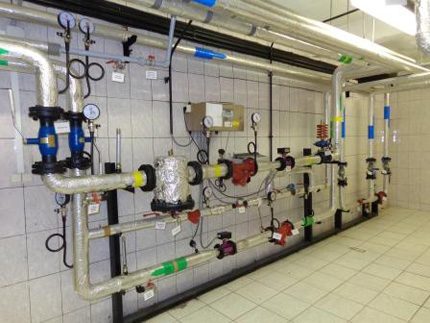
Circulation schemes should be provided for hot water supply points (for the period of lack thereof), if there is a need to continuously maintain the temperature within the limits established by the norm within 60-75 ° C.
At the same time, it is forbidden to connect the water folding units directly to the pipelines of the circulation system. Pressure losses in circuits are not allowed more than 10% of the pressure value in other areas.
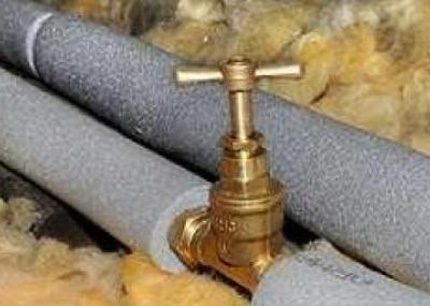
Norm for the maximum allowable value water pressure inside the drinking water supply system is 0.45 MPa (4.5 atm.) at the point of the plumbing fixture located at a level below all others existing in the scheme.
The pressure at the points of plumbing fixtures located above all others should correspond to the nameplate values of these fixtures. In the absence of a document, they are guided by the lower boundary - 0.2 MPa (2.0 atm.).
If the pressure exceeds the specified standards, installation must be provided. pressure reducer or similar devices capable of lowering the water pressure to normal values.
These devices should provide calculated pressure standards in the static and dynamic modes of operation of the drinking water supply. It is also allowed to use valves equipped with built-in flow controllers - water meters.
Materials taken for installation and wiring of internal water supply systems, including fittings, pipes and equipment, must comply with the requirements of sanitary and epidemiological norms, national standards, SNiP.
Lines for drinking water may be built and put into operation only upon passing a sanitary-epidemiological examination, obtaining the relevant permits and certificates.
Communication device in a country house
The equipment of a country house with communications according to technological methods and principles is similar to the arrangement of a city apartment. The only difference is that water supply systems with a sewage system for a private facility should take into account the possibility of conservation.
This circumstance is provided for in the design, regardless of whether the house is connected to centralized networks or for it on the site independent water intake arranged and installed a local sewage treatment plant - septic tank or VOC.
Water supply network construction
The process of constructing domestic hot water / cold water pipelines should include the installation of non-return valves, provided that more than one input is created in the area of the internal water supply network.
The horizontal distance between the water supply inlet with a diameter of up to 200 mm and the outlet of the sewage system (according to the established standards) is at least 1.5 m. If the inlet is made of a pipe with a diameter of more than 200 mm, the norm for the horizontal distance to the sewage outlet is increased to 3 m.
During installation, it is necessary to put emphasis in the places of turns of pipelines (along the horizontal and vertical axes), if mechanical stresses are not compensated by the connection diagram.
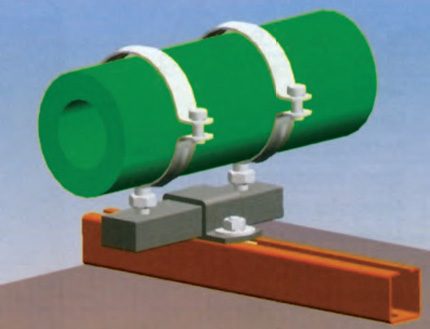
The rules establish that the distribution lines HVS / GVS for projects of residential buildings are mounted on the following sites:
- in the basements;
- in the attics;
- under the floor - subject to removable cover;
- under the ceiling of non-residential premises;
- on technical floors;
- in the underground.
The passage in the wall of the building at the place of its intersection with the input pipeline is made with a gap of at least 200 mm from the pipe surface to the elements of building structures. After installation, the hole is sealed with an elastic waterproof and gas-tight material. Such installation is provided for dry soil. On wet soils, oil seals are used instead of terminations.
Concealed and open pipe laying
The risers and hot water / cold water inputs, metering devices, valves, control modules are located in communication shafts, in technical cabinets specially provided for such purposes.
Free access to technical cabinets is required. Open laying of risers and wiring is allowed along the walls of kitchens, showers, toilets, taking into account the placement of valves and control devices.
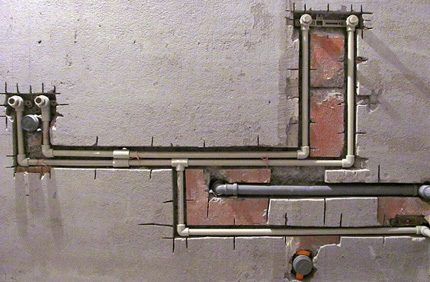
If used polymer water pipesthen a hidden type gasket is provided. The exception is the lines of sanitary facilities. But it is forbidden to secretly lay steel pipelines with threaded connections without creating conditions for free access to these connections.
According to the requirements, the laying of lines is performed with a slope of at least 2 mm per meter of length. With appropriate justification, this norm can be reduced to 1 mm.
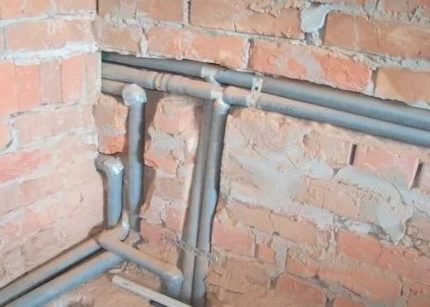
The HVS water supply, designed for year-round operation, is mounted indoors, where the minimum temperature is + 2 ° C. If it is impossible to create such conditions, then they carry out installation with frost protection of the pipes - they equip additional heating, for example, mount heating cable.
Thermal insulation of pipeline sections located in areas of short-term temperature reduction to 0 ° C and below is mandatory. The same requirements are relevant for lines located at the entrance doors or in other places in contact with the outside air.
Removing system air
The DHW piping scheme should include the installation of air vents and air vents. Air vent devices should be mounted in areas divorced at maximum height relative to the entire circuit.
Instead of air vents, it is allowed to use water-folding fittings, also mounted on high-altitude areas. The drain devices are mounted at the lower points of the circuit, if it is not provided for installation at the same lower points of the valves.
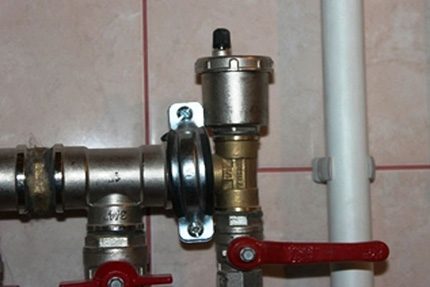
The development of each DHW project should include the production of measures aimed at compensating for deformations of water pipes that inevitably arise in the process of changing water temperature. The hot water supply circuit is designed for a fluid velocity of not higher than 1.5 m / s.
Design decisions should take into account the service life of pipes and parts of hot / cold water supply schemes.
Regulatory data:
- not less than 50 years - at temperature operating conditions up to 20ºС;
- not less than 25 years - at a temperature condition up to 75ºС.
These standards take into account the hydraulic resistance, the value of which must remain unchanged for the indicated periods.
Water consumption measurement
Buildings equipped with cold water / hot water supply must be equipped water metering units. Measuring equipment is installed at the points of the cold water / hot water supply in each building, apartment. Also, the rules require the installation of meters on branch pipelines that are sent to any non-residential attached premises.
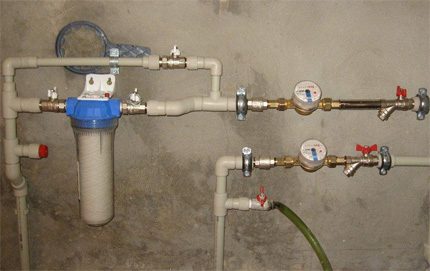
On domestic hot water lines with water temperatures up to 90 ° С it is required to mount measuring equipment on the supply and circulation pipelines. In this case, the circulation pipe is additionally equipped with a check valve.
In the direction of travel in the area in front of the meter, it is necessary to include filters - mechanical or magnetic-mechanical. Install filter elements should be subject to allowable pressure losses of not more than 50%.
At the input of the HVS, the meters are installed in rooms where easy easy access is open, where it has artificial or natural lighting, and the ambient temperature does not drop below 5 ° C.
Meanwhile, it is recommended that the hot / cold water consumption meters be installed in a single place. Installation of devices should provide convenient free access for reading information.
Water meters are installed on supports or brackets. The rules require that the meters be protected against vibrations and mechanical stresses transmitted by pipelines.
If there are no conditions for placing meters in the room, it is allowed to put them outside buildings, inside special wells. In this case, the device must be designed for operation in a flooded form.
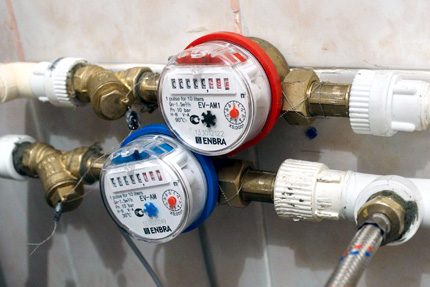
The rules allow installation on vertical or inclined sections, if such installation is permissible according to the device certificate. For placement on vertical sections of pipelines in residential premises, it is allowed to put meters from the class “A” group.
The circuit layout of the counters provides:
- cranes on both sides of the device;
- creation of direct plots pipes on both sides of the device;
- bypass line - only for cold water.
All installed meters, as well as stop valves (in the open state) must be sealed.
Arrangement of internal sewerage
Based on the purpose of the building, the construction of an internal sewage system is provided:
- sanitary - collection and disposal of household liquids from sanitary plumbing appliances (sinks, toilets, bathtubs, etc.);
- production - collection and disposal of industrial effluents;
- gutter - collection and disposal of precipitation products.
For domestic household sewage installation of gravity pipelines, usually closed.
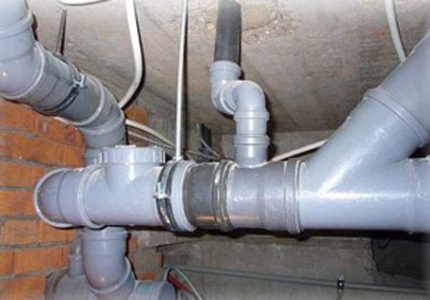
Production effluents can be discharged through open chute systems if the effluents do not emit harmful gases, vapors and do not leave unpleasant odors. It is recommended to lay sections of any sewage system strictly rectilinearly with a given slope.
Standards for laying and mounting lines
The outlet pipelines are connected to the risers by means of oblique crosses and tees. If you are connecting branch pipes from several plumbing fixtures located at the same level mark, only oblique crosses should be used.
It is not permissible to use straight crosses for removal, provided that they are placed along the horizontal axis.
Lines of internal sewerage of non-pressure (pressure) type must be made on the basis of pipes and fittings, the service life of which is at least 25 years. Technical fittings must ensure the stability of hydraulic resistance throughout the life of the system.
Recommended sewer pipes and fittings made of polymers.
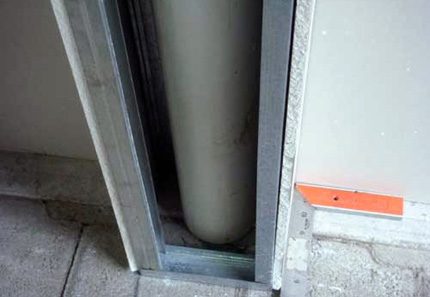
Thus, the laying of sewer lines from polymer pipes is carried out with the following standards:
- hidden installation of risers (in mines, ducts) with front panel equipment;
- material of mines and boxes non-combustible;
- the material of the front panel of the shafts of the boxes corresponds to the combustibility group "G2";
- open laying of polymer pipes is carried out in the basements of buildings;
- the riser section rising 80-100 mm above the floor slab is insulated and cemented with a 20-30 mm mortar layer.
It is forbidden to carry out hidden (open) laying of sewers inside the walls, inside the floor structure, under the ceiling of residential premises of any purpose.
It is allowed to introduce several sewage systems into the structure of multifunctional buildings for the drainage of liquids with different degrees of aggressiveness of the environment.
Separation of domestic and industrial sewage systems is mandatory subject to outgoing industrial effluents that require treatment, treatment and the subsequent organization of recycled water supply.
Ventilated risers: calculation and installation
It is necessary to provide for the creation of ventilated risers connected to the points of sewer lines located along the upper horizon. Ventilated risers should be led out through the roof of buildings.
On buildings with a flat and pitched non-exploitable roof fan pipe setby raising above the roof level not lower than 200 mm. In this case, the outlet point of the ventilated riser pipe should be removed from nearby windows at a distance of at least 4 m.
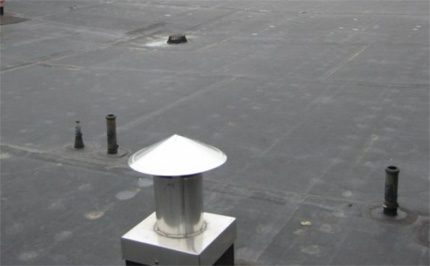
On operated roofs, the ventilated riser outlet must rise above the roof by at least 3 m and combine at least 4 separate risers. It is allowed to raise each individual riser below the level of the roof in use, but in this case, a non-return ventilation valve should be introduced, passing air only into the pipe.
The valve should be installed at the level of plumbing fixtures located on the highest horizon of the sewage system.
The estimated number of ventilated risers (air exchange rate) is determined by the formula:
N = kW / Q,
Where:
- N - number of risers;
- k - the rate of air exchange to the riser, l / day (the norm for calculating 80-100);
- W - sewerage network volume, m3;
- Q - daily amount of dirty air at the outlet of the riser, m3 (for calculation 320).
The minimum possible deepening of sewer pipes should be determined taking into account the existing permanent and temporary loads. If there is a risk of damage to pipelines from mechanical stress, they should be protected.
In areas where there is a risk of lowering the ambient temperature to negative values, warming should be used.
Laying sewer pipes in a system made without standard calculation is allowed with a slope calculated by the formula:
1 / D,
Where D - the diameter of the pipes used.
For networks inside residential (domestic) premises, the depth of laying sewer pipelines should be at least 100 mm from the top of the pipe to the floor level. It is unacceptable to change the slope in the sections of the horizontal outlet pipes.
Inside buildings, the installation of plumbing fixtures (sink receivers) is required. The number of such devices is determined by the architectural and construction project of the facility. All plumbing fixtures must be equipped with water locks (siphons) - devices that block the outlet of the gas medium of the sewage system into the premises.
Conclusions and useful video on the topic
Experience in arranging water supply and sewage systems in a private house:
In the process of construction or repair of water supply and sewer networks, it is necessary to be guided by rules, norms, standards. Compliance with technological recommendations, following standards and norms is the key to building effective and durable communications.
Do you have experience in arranging an internal water supply system or sewer network? Please share information with our readers, tell us about the features of highway planning. You can leave comments in the form below.

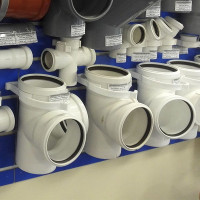 Silent sewage: principles of arrangement and installation examples
Silent sewage: principles of arrangement and installation examples 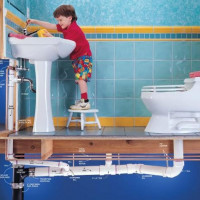 Do-it-yourself sewerage in an apartment: rules for internal wiring and installation
Do-it-yourself sewerage in an apartment: rules for internal wiring and installation 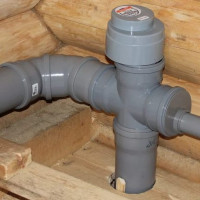 Internal sewerage: device options in an apartment and a private house
Internal sewerage: device options in an apartment and a private house 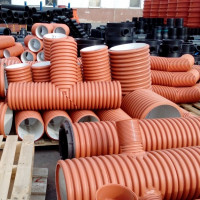 Corrugated pipes for external sewage: types, rules and standards of application
Corrugated pipes for external sewage: types, rules and standards of application  An example of calculating sewage slope: formulas and technological standards
An example of calculating sewage slope: formulas and technological standards  How much does it cost to connect gas to a private house: the price of organizing gas supply
How much does it cost to connect gas to a private house: the price of organizing gas supply  The best washing machines with dryer: model rating and customer tips
The best washing machines with dryer: model rating and customer tips  What is the color temperature of light and the nuances of choosing the temperature of the lamps to suit your needs
What is the color temperature of light and the nuances of choosing the temperature of the lamps to suit your needs  Replacement of a geyser in an apartment: replacement paperwork + basic norms and requirements
Replacement of a geyser in an apartment: replacement paperwork + basic norms and requirements
There was a need to install a dishwasher at home with a drain into the sewer (in the kitchen). The problem is that you want a full-sized, rather than a “sink” model with a ready-made conclusion. In the corner where the main riser passes and the sink is located, there is no place for anything other than a kitchen sink. We have a corner set, and it’s in the corner of the risers and also the ventilation shaft. If you put it on the second side of the ventilation, then how to pull the drain outlet? It is impossible through the ventilation shaft, under the floor in any way, above the floor - not aesthetically ... What are your thoughts on this?
At first glance, the problem seems quite serious, but here you can find a practical and aesthetic solution. Place the dishwasher in the place that suits you best; don’t worry about the distance from the drain.
You can connect the drain of the dishwasher to the sink by increasing the hose to the required length, choosing one of two connection methods (I attach the photo). Or connect to the drain pipe using a transition sleeve. All communication hoses can be aesthetically hidden in special boxes so that they do not spoil the interior.
Last year, they bought a house with a central water supply, and in winter, in severe frosts, they were faced with the fact that the pipes froze. Of course, it was a shock, the walls were opened, it turned out that the system was not thermally insulated. I had to warm all communications myself, the work is very painstaking and requires special skills. But everything seemed to work out, this winter goes without surprises. It is important when buying real estate to pay attention to how the water supply is made.
Undoubtedly, high-quality installation is of great value for subsequent operation. Thank. The article is very visual and informative.